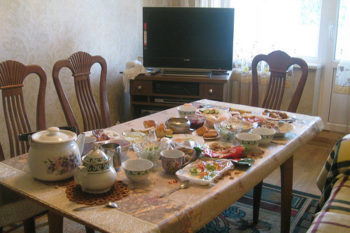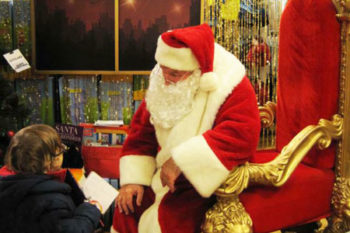The Festa dos Tabuleiros (Festival of the Trays) is one of the most important celebrations in Portugal. It takes place every four years, during the months of June or July, in Tomar, the city of the Templars, located in the centre of Portugal. These celebrations are also known as the Festa do Espírito Santo (Holy Spirit Celebration). I was there for the first and only time in 2007, four months before I came to live in The Netherlands.

Streets of Tomar, decorated for the festival
The festival takes its name from the trays carried during the final procession. It originated during the rule of the Farmer King, Dom Dinis and his wife, Queen Saint Isabel. During their reign the Portuguese borders were defined with Tratado de Alcanices (1297), Portuguese language became the State official language (in 1290), the first Portuguese University was founded and agriculture, culture, the arts and poor people were well protected.
The tabuleiros which the girls carry in the procession are decorated with symbols of the Holy Spirit: on top of the tray there is a pigeon and the crown, and from the top to the bottom, 30 loaves of bread, colourful paper flowers (generally field poppies) and ears of corn. All the sixteen disctricts of Tomar are represented in this procession, which takes place in the main streets of the town. Houses are decorated for the occasion with quilts hanging from the verandas. During the procession there is a shower of flower petals. Each tabuleiro (tray) has the same height as the girl who carries it.
These are some of the most special moments from the festival:
O Cortejo das Coroas (Procession of Crowns)
This procession (the first solemn act of the Festas dos Tabuleiros) is followed by the Mass of the Holy Spirit with seven crowns that symbolise the seven days of the week, the day God took His rest, the gifts of the Holy Spirit, and the Sundays between Easter and Pentecost.
O Cortejo dos Rapazes (The Boys Procession)
In spite of the name, there are little girls in this procession. They wear white dresses with a colourful ribbon round their waist and carry their own tabuleiros. The little boys dress in black trousers, white shirts and a tie in the colour of the ribbon used by the little girl next to him.
The main goal of this procession is to promote the traditions among the youngest ones.
O Cortejo do Mordomo (The Butler Procession)
This procession is also called “A Chegada dos Bois” or The Arrival of the Cattle. The Butlers (the heads of the procession) are followed by cattle decorated with flowers. During the procession there are fireworks and music. Until 1966, the cattle used to be killed after the procession and the meat shared among the people, rich and poor, as a symbol of a brotherhood of man. Nowadays, the meat is bought in the butchers and shared only among the poorest families.
O Cortejo dos Tabuleiros (The Main Procession)
Two long lines with young women, each one of them with her tabuleiro on the top of her head, go on the procession through the main streets of Tomar. Next to them, the men, giving support and attention. After the arrival into the main square, Praça da República (Republic Square), someone of the Catholic Church come and bless the tabuleiros. A signal is given by a bell and then the most emotional moment happens. It’s the “elevação” when the tabuleiros are elevated in front of the people.
O Bodo ou Pêza
It’s the sacred meal of the last day of the celebrations where the meat, the bread and the wine are shared among the poorest people.
This year, the Festa dos Tabuleiros took place in Tomar between 2 and 11 July. The program was as it follows:
July, 3 (Sunday) – Cortejo dos Rapazes (Boy’s Procession)
July, 8 (Friday) – Cortejo do Mordomo (Buttler’s Procession) and Open of the decorated streets with colourful paper flowers
July, 9 (Saturday) – Cortejos Parciais dos Tabuleiros (districts Tabuleiros processions)
July, 10 (Sunday) – Cortejo dos Tabuleiros (Main Tabuleiros Procession)
July, 11 (Monday) – Bodo ou Pêza (the sacred shared meal among the poorest ones)
Four years ago when I went to Tomar it was only to watch the main procession (Cortejo dos Tabuleiros) and the beautiful decorated streets with paper flowers. I even bought one yellow paper flower that I treasure very much. As you can see in the photo below, she is decorating my dining table! I love paper flowers! It reminds me of my childhood during the Popular Saints Festivities in June. I used to know how to make them when I was twelve.

Yellow paper flower from Tomar
If you stay in Tomar during the Festa dos Tabuleiros week, you will also have a great city to enjoy. Tomar’s Convent of the Order of Christ (O Convento de Cristo) is one of the most important historical and artistic Portuguese monuments and a World Heritage Site since 1983. This Castle was built by Gualdim Pais, the provincial master of the Order of the Temple, around 1160.
One of my best memories of this castle dates from a very special evening. The Tomar Theater Group, Fatias de Cá, was representing there “The Name of the Rose” by Umberto Eco. We enjoyed the play by following the actors through the different rooms, corridors and cloisters of the Castle and stopped once in a while in the medieval kitchen for a medieval dinner.
The Seven Hills Woods (A Mata dos Sete Montes) is the biggest park of the city and it is located next to the Castle. A very beautiful place where you can enjoy a summer picnic or a stroll.
Another historical place to visit is the best preserved of the medieval synagoges in Portugal, also the place of the Jewish Museum Abraão Zacut. The museum of Tomar Synagoge is named after King John II of Portugal’s Royal Astronomer.
Finally, don’t leave Tomar without a box of their traditional cookies, Beija-me Depressa, that means Kiss me Quickly!
Hope you have enjoyed the Festa dos Tabuleiros and the town of Tomar!
I leave you with a slideshow of the streets of Tomar decorated for the celebrations.
Read more:
Festivals from around the world
Summer solstice celebrations in France
Portugal’s young fado generation






Gostei muito do post. Nunca assisti a esta festa, mas gostava. Bj!
Very beautiful this celebrations, plenty of colours and symbols. But I have a question: All the flowers are made in paper? Because it´s a great job!!
Very interesting!!
@ Thanks, Margarida! Indeed, it deserves a visit. I’m sure you will enjoy it very much! 🙂
@ Ola Patricia! 🙂 In fact, the flowers are all made in paper. It is indeed a great job, as you say! That’s why the Festival takes place only each 4 years!
Sandra,
Gostei imenso desta viagem. Este ano houve festa como referiu, estava para ir mas surgiram imprevistos e não fui. lamento porque adorei a sua descrição.
Vou muitas vezes ao Castelo dos Templários e Convento de Cristo porque me sinto muito bem lá. É uma forma de admirar a beleza e de encontrar apaziguamento.
Estive no Convento três dias antes da festa mas…
Os bolos que menciona são uma delícia, a cidade é linda!
A sinagoga é também interessante de visitar.
Nas Fatias de Cá tenho lá um amigo e eles são fantásticos.
Beijinhos de Portugal e estou grata por este postal! :))
@Ana: Me too, I just love to go to the Castle and the Convent 🙂
A very peaceful place as you say! 🙂 Bjs!